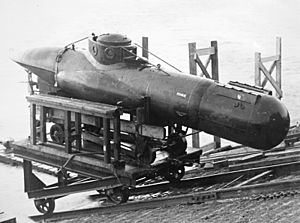Welman submarine facts for kids
class="infobox " style="float: right; clear: right; width: 315px; border-spacing: 2px; text-align: left; font-size: 90%;"
| colspan="2" style="text-align: center; font-size: 90%; line-height: 1.5em;" | 
|} The Welman submarine was a very small, one-person submarine used by the British during World War II. It was developed by a secret organization called the Special Operations Executive (SOE). This mini-submarine was only used in real missions once and wasn't very successful.
Contents
| Class overview | |
|---|---|
| Name: | Welman submarine |
| Builders: | Morris Motors Limited |
| Operators: | |
| Completed: | 100+ |
| General characteristics Welman submarine | |
| Type | midget submarine |
| Displacement |
|
| Length |
|
| Propulsion | One electric motor, 2.5 hp, powered by a 40v 220amp/hr battery. |
| Speed | 3 knots (5.6 km/h) |
| Range | 36 nautical miles (67 km) at 3 knots (5.6 km/h) |
| Test depth | 300 ft (91 m) (reduced to 100 ft (30 m) after trials) |
| Crew | 1 |
| Armament | 1 x detachable charge of 425 pounds (193 kg) of Torpex |
What Was the Welman Submarine?
The Welman was a special type of midget submarine, which means it was much smaller than regular submarines. It was designed to carry a large bomb and attach it to enemy ships. Unlike other mini-subs where the operator rode outside, the Welman kept its single pilot safely inside.
How Was the Welman Designed?
Lieutenant Colonel John Dolphin from the SOE's research department designed the Welman. The idea was to deliver a powerful explosive charge right under an enemy ship. The submarine was about 20 feet 6 inches (6.25 m) long, including the bomb, and weighed around 2,000 pounds (910 kg).
The pilot sat inside the submarine. They didn't need to wear diving gear. The Welman could carry a 425-pound (193 kg) bomb made of Torpex, a very strong explosive. This bomb was meant to stick to the target ship using magnets. The pilot could see out through strong glass windows in the small conning tower (the top part of the submarine), but there was no periscope to look around without surfacing.
Making the Welman Submarine
After testing the Welman in the Queen Mary Reservoir near Staines in late 1942, it was decided to start building them. The job of making these submarines went to Morris Motors Limited at their factory in Oxford.
Why Production Stopped
Even though the Welman couldn't get through anti-submarine nets (which are nets used to stop submarines) and the pilot had poor visibility, the British military ordered 150 of them in February 1943.
However, by October 1943, studies showed that the Welman had too many problems. So, production was stopped. By that time, about 100 Welman submarines had been built, though the exact number isn't known.
Welman in Action
In early 1943, the Royal Navy began testing the Welman at sea. This happened on HMS Titania, a ship that supported submarines. Pilots were trained at Fort Blockhouse in Gosport. These trainees came from the Royal Navy and other special forces groups, like the Special Boat Section of the Commandos.
HMS Titania later moved to Loch a' Chàirn Bhàin in Scotland. This became a secret training base for all mini-submarine operations. During training, one Welman (W10) was lost in Rothesay Bay on September 9.
By autumn 1943, there were enough trained pilots and Welman submarines ready for missions.
The Norway Mission
In the autumn of 1943, General Sir Robert Laycock, who was in charge of Combined Operations, decided the Welman wasn't right for their main goals. So, the submarines were given back to the Royal Navy. Admiral Sir Lionel Wells thought they could be useful for attacking German ships along the coast of Norway.
Motor Torpedo Boats (MTBs), which are fast attack boats, were already raiding these areas. They agreed to try using the Welmans to attack a floating dock in Bergen harbour.
On November 20, 1943, two MTBs, MTB635 and MTB625, left Lunna Voe, Shetland. They carried four Welman submarines: W45, W46, W47, and W48. The Welmans were launched at the entrance to the fjord (a narrow sea inlet).
One of the Welmans, W46, piloted by Lieutenant Bjørn Pedersen (1922), hit an anti-submarine net. This forced the submarine to the surface, where a German patrol boat spotted it. Pedersen was captured, but he survived the war in a prison camp. The other three Welmans had lost the element of surprise. They couldn't continue their attack and had to be scuttled (sunk on purpose). Their pilots escaped with help from Norwegian resistance fighters and were picked up by another MTB in February 1944.
After the Mission
Because this mission failed, the Royal Navy decided to focus on other types of mini-submarines, like the X craft and XE craft. However, some more Welman tests did happen, especially in Australia.
The Germans later found and salvaged one of the Welman submarines. Even though the German navy thought the Welman's engineering was simple, their own Biber midget submarines, used in 1944, had some similarities to the Welman.
The biggest problem with the Welman, from the pilots' point of view, was that it didn't have a periscope. Without a way to see what was around them without coming to the surface, it was impossible to navigate secretly. Also, when traveling on the surface, the pilot's eyes were so close to the water that they couldn't see anything more than two miles away.
See also

